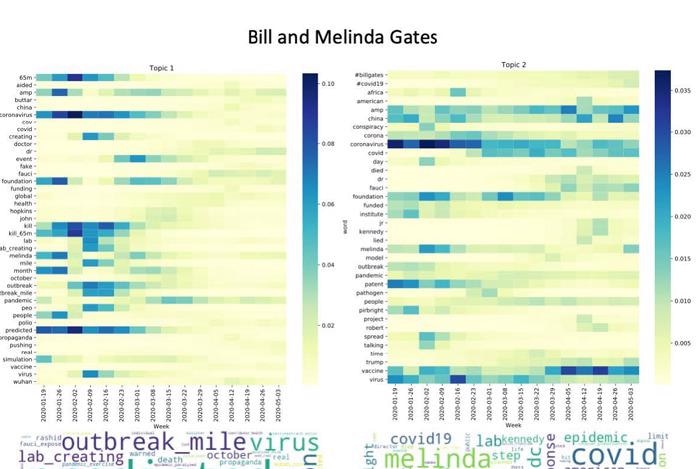Apr 20 2021
Researchers have developed a new machine-learning program that precisely determines the COVID-19-linked conspiracy theories on social media and models how they developed with respect to time. This tool could someday assist public health officials to fight misinformation online.
 This image shows the change in word importance over time for tweets related to the Bill and Melinda Gates conspiracy theory. In the top panel, the x-axis represents time while the y-axis shows important words. Color represents the importance of words, with darker color indicating higher importance. In the bottom panel are word clouds for each topic. Word size corresponds to word weight (higher weighted words appear larger). Image Credit: Los Alamos National Laboratory.
This image shows the change in word importance over time for tweets related to the Bill and Melinda Gates conspiracy theory. In the top panel, the x-axis represents time while the y-axis shows important words. Color represents the importance of words, with darker color indicating higher importance. In the bottom panel are word clouds for each topic. Word size corresponds to word weight (higher weighted words appear larger). Image Credit: Los Alamos National Laboratory.
A lot of machine-learning studies related to misinformation on social media focus on identifying different kinds of conspiracy theories. “Instead, we wanted to create a more cohesive understanding of how misinformation changes as it spreads.
Courtney Shelley, Postdoctoral Researcher, Information Systems and Modeling Group, Los Alamos National Laboratory
“Because people tend to believe the first message they encounter, public health officials could someday monitor which conspiracy theories are gaining traction on social media and craft factual public information campaigns to preempt widespread acceptance of falsehood,” added Shelley.
Shelley is the co-author of the study that was published recently in the Journal of Medical Internet Research.
The research titled “Thought I’d Share First” employed open-source, anonymized Twitter data to describe four COVID-19 conspiracy theory themes and offer context for each through the initial five months of the pandemic.
The four themes analyzed by the study are as follows: 5G cell towers distribute the virus; Bill and Melinda Gates Foundation devised or has otherwise malicious intent associated with COVID-19; the virus was bioengineered or was made in a laboratory; the COVID-19 vaccines, which are all still under development, would be hazardous.
We began with a dataset of approximately 1.8 million tweets that contained COVID-19 keywords or were from health-related Twitter accounts. From this body of data, we identified subsets that matched the four conspiracy theories using pattern filtering, and hand labeled several hundred tweets in each conspiracy theory category to construct training sets.
Dax Gerts, Study Co-Author and Computer Scientist, Information Systems and Modeling Group, Los Alamos National Laboratory
The researchers used the data gathered for each of the four theories to create random forest machine-learning, or artificial intelligence (AI), models that classified whether or not tweets were COVID-19 misinformation.
“This allowed us to observe the way individuals talk about these conspiracy theories on social media, and observe changes over time,” stated Gerts.
The study revealed that misinformation tweets consist of more negative sentiment than factual tweets and that conspiracy theories develop over time, including details from independent conspiracy theories as well as real-world events.
For instance, Bill Gates took part in a Reddit “Ask Me Anything” in March 2020, which stressed Gates-funded study to develop injectable invisible ink that could be utilized to record vaccinations.
Soon, an increase in the significance of words linked with vaccine-averse conspiracy theories occurred, noting that the COVID-19 vaccine would secretly microchip people for the control of the population.
Moreover, the study discovered that a monitored learning method could be employed to automatically find conspiracy theories, and that an unattended learning method (dynamic topic modeling) could be employed to examine variation in word significance among topics related to each theory.
It’s important for public health officials to know how conspiracy theories are evolving and gaining traction over time. Not, they run the risk of inadvertently publicizing conspiracy theories that might otherwise ‘die on the vine.’ So, knowing how conspiracy theories are changing and perhaps incorporating other theories or real-world events is important when strategizing how to counter them with factual public information campaigns.
Courtney Shelley, Postdoctoral Researcher, Information Systems and Modeling Group, Los Alamos National Laboratory
Journal Reference:
Gerts, D., et al. (2021) “Thought I’d Share First” and Other Conspiracy Theory Tweets from the COVID-19 Infodemic: Exploratory Study. Journal of Medical Internet Research. doi.org/10.2196/26527.